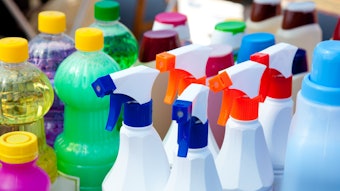
In December 2008, I met Daniel Fabricant, vice president of scientific and regulatory affairs for the Natural Products Association (NPA) at the association’s headquarters in Washington, DC, with a view to explore the practicality of developing a natural product standard for household cleaning products. The collaboration between the NPA and a team of experts in the personal care industry, and the subsequent introduction of the NPA Natural Personal Care standard (May 2008) was the hallmark of our discussion. Clearly, the question before us was, “Does the spillover effect of the natural, green sustainability movement that has so clearly impacted personal care extend to home care products—specifically, the household cleaning and laundry category?” And as research indicated, that opportunities were plenty.
Market Research Indicators
According to Chicago-based market research firm, Information Resources, Inc. (IRI), total home care products sales (see F-1) (including “green”) ending Nov. 1, 2009 were:
- Laundry detergent: $3.72 billion
- Household cleaners: $1.5 billion
- All-purpose cleaners: $393 million
- Toilet deodorizers/cleaners: $250 million
- Tub/tile cleaners: $235 million
- Spray disinfectant: $111 million
Meanwhile, according to a Progressive Grocer magazine article (April 2009), “Consumers seeking ways to ‘go green’ and protect the environment and their families by avoiding chemicals are grabbing natural all-purpose household cleaners off store shelves at a record pace.” Mintel, a market research company based in Chicago, has projected growth in the category to reach $623 million by 2013. Considering the category has already grown from $17.7 million in 2003 to a whopping $64.5 million in 2008, this increase seems attainable. Then again, a recent Associated Press report suggested that when Clorox entered the green market in December 2007, the natural category accounted for only about 1% of the $12 billion spent on cleaning products (including industrial) each year in the United States. Although only out for a little over a year, Clorox's Green Works is the market leader in natural household cleaners, with 45% of category sales, according to Mintel. Finally, a recent national survey* found that natural ingredients are important to consumers; 78% of those surveyed said there should be regulations/standards for natural home care products; 72% believed it’s important that ingredients in home care products are natural; and 73% said they are more likely to purchase a home care product if they know it is certified as natural.
The Outcome: NPA Seal for Home Care Products
In response to the above industry indications, the NPA has extended its seal and standard to include home care products such as household cleaners, laundry detergents and the other categories detailed earlier. This will help consumers discern which products are natural (according to NPA). Shoppers can expect the seal to begin appearing on certified home care products in the coming months. Of this, Fabricant says, “This new standard for home care products is the next step in returning the integrity to the word natural. A number of products that mainly [use] synthetics are being positioned as natural. This leads to significant consumer confusion about the category and the products people are choosing.”
The NPA home care natural standard is science-based and, like the personal care natural standard before it, has been developed by a team of advisers from the NPA and home care manufacturers including Green Works, Seventh Generation, JR Watkins, Cognis, Trilogy Fragrances, Aubrey Organics, PCC Natural Markets, Green Mountain, EcoMe, and Sun & Earth. The advisory panel drew from a variety of sources, including relevant international standards, third-party organizations, existing research and years of experience in the field.
Certification Criteria
The following is the initial standard as of Feb. 11, 2010. The full set of criteria can be found on the NPA’s Web site. The standard requires natural ingredients to be made with the illustrative allowed processes listed in the sidebar.The new program requires products to follow strict guidelines set out by the NPA to merit the seal. The criteria include, but are not limited to, the following:
- Product must comprise at least 95% truly natural ingredients or ingredients that are derived from natural sources
- No ingredients with any potential suspected human health risks
- No processes that significantly or adversely alter the purity/effect of the natural ingredients
- Ingredients that come from a purposeful, renewable/plentiful source found in nature (flora, fauna, mineral)
- Processes that are minimal and don't use synthetic/harsh chemicals or otherwise dilute purity
- Non-natural ingredients only when viable natural alternative ingredients are unavailable and only when there are absolutely no suspected potential human health risks
- Transparency and full disclose of ingredients per CSPA Voluntary Ingredient Communications Program
- No animal testing
- Transparency and full disclosure of ingredients on product label per CSPA Voluntary Ingredient Communications Program
- Compliance with FTC and NAD guidelines
- Certificant must strive to maximize use of recyclable and PCR materials in packaging
- All ingredient information (i.e. raw material sources, processing information) must be disclosed in submission documentation
- 60% of the brand must qualify for NPA Natural Certification regardless of whether 60% actually undergoes certification
- Product certification term is two years and products will be reviewed every two years to maintain certification
An allowed synthetic non-natural ingredient (see Appendix) can be used only when:
- There is not a readily available, commercially viable, natural alternative ingredient equivalent
- There are no suspected human health hazards as identified by appearing in the authoritative lists of prohibited ingredients
- Required for trade-acceptable product
- Made using allowed processes
- Synthetic does not appear on the prohibited processes nor prohibited ingredients list below.
- Synthetic ingredients may not be used at more than a 5% cumulative level in the total formula (calculations do not include water).
The standard further prohibits ingredients that:
- Are animal-based materials where the animal is harmed
- Are byproducts of animal renderings
- Have suspected human health hazards as indicated by authoritative organizations and appear on prohibited substance lists, i.e. no carcinogens (1), mutagens (2) or reproductive toxicants (3); no endocrine disruptors (4); no ingredients identified as hazardous waste (5); and no environmentally persistent, bioaccumulative or toxic compounds (5)**
- Are made with, but not limited to the following processes:
- Processes which are inconsistent with the 12 Principles of Green Engineering (6)
- Processes which create undesirable by-products or impurities such as 1,4-dioxane, parabens, heavy metals, formaldehyde, such as: benzene processing which creates parabens; acidification of ethoxylates which produces 1,4 dioxane; petrolatum/mineral oil/paraffin produced from petrochemical sources which contain undesirable impurities
- Processes which create carcinogens, mutagens, reproductive toxins, or endocrine disruptors
- Processes which use ingredients or create byproducts that could become hazardous waste
- Processes which use or create environmentally persistent, bioaccumulative, toxic, or neurotoxic compounds
- Processes which use animal by-products where the animal is harmed
The following is an illustrative list of classifications of ingredients that are prohibited includes:
- Parabens: Synthetic preservatives that are potential endocrine disruptors petrolatum/mineral oil/paraffin: Non-renewable by-products of crude oil with potentially dangerous impurities
- Synthetic glycols: Petroleum derived synthetic chemicals that can potentially draw other chemicals into the bloodstream
- Phthalates: Synthetic fragrance components that are potential toxins
- Ethoxylated ingredients: Like sodium myreth sulfate and sodium laureth sulfate, PEGs or PPGs, which are made in part with the petrochemical ethylene oxide and results in 1,4-dioxane as a trace contaminant (1,4-dioxane classified as a possible carcinogen)
- Ethanolamines like MEA/DEA/TEA: Foam and viscosity boosting ingredients that can interact with other ingredients to form nitrosamines, a known carcinogen
- Synthetic polymers (PVP/acrylates): That contain residual PAHs (polycyclic aromatic hydrocarbons)
- Formaldehyde donors (DMDM hydantoin/diazolidinyl urea): Preservatives that work by releasing formaldehyde
For a longer list of prohibited ingredients, see sidebar.
The NPA Seal: Terms and Conditions
In 2010, consumers will begin to see the NPA seal (pictured) on home care products. NPA member and non-member suppliers whose products have been audited by an NPA standard and certification program for natural home care products auditor and found to be in compliance, shall have the right to utilize the program’s certification seal (Natural Standard Seal) for natural home care products that have been reviewed and certified “natural” under the following terms and conditions:
- For the purposes of the Natural Standard Certification Program, the term “supplier” shall be defined as any company that designs, manufacturers, fabricates, assembles, or processes a natural home care product. This includes contract manufacturers, specification developers, repackers, relabelers and private label distributors of home care products.
- The Natural Products Association member supplier can use the seal as provided in these Terms of Use indefinitely, provided that:
- the formulation certified does not change
- the member of the association must be a member in good standing (has paid dues and fulfilled other membership requirements)
- the member supplier makes timely payment of the renewal fee in the Natural Products Association Certification Seal and Award for Natural Home Care Products (for which the manufacturer/member supplier will be separately billed)
- no verifiable information comes to Natural Products Association's or the Steering Committees’ attention that products advertised or promoted under the Seal have fallen out of essential compliance with Natural Standard Certification Program standard
- Only companies with home care products that are certified under the Natural Products Association Standard and Certification Program for Natural Home Care Products may reference the program, or their compliance with the program, in any or all of their advertising. Natural Standard Certification Program companies are required to prohibit companies that they manufacture, package, label, and warehouse or distribute for from referencing the Natural Standard Certification Program in any or all of their advertising, unless that company’s products have also been reviewed and certified under the Natural Products Association Natural Certification Program.
Footnotes:
* Based on a national online survey of 1,002 consumers with partner Braun Research on Sept. 17, 2009, about natural home care products. The findings have a margin of error of +/- 3 percentage points at the 95% confidence level.
** (1)Carcinogens: IARC Group 1, 2A, 2B; REACH Carcinogens 1, 2; NTP – Known or Reasonably Anticipated Human Carcinogens; EPA IRIS; Prop 65 Carcinogen (relevant exposures for consumer product use or manufacturing); NIOSH Potential Carcinogen; EPA IRIS Carcinogen Assessment; (2) Mutagens: REACH Mutagen Category 2; (3) Reproductive and Developmental: Prop 65 Devel; Prop 65 Male, Female Repro; REACH Repro Tox 1, 2; (4) Endocrine Disruptors: EU Cat 1, 2 and with data quality category DQ1; (5) Hazardous Waste: RCRA lists U, P, D 6 CERCLA/SARA 313 PBT; EU POPs; RCRA Waste Minimization; EPA Priority; Interim Review for the Strategy for Cooperation and Networking Between EU Member States and EFSA PBT Assessment; EU vPvT; (6) https://portal.acs.org/portal/PublicWebSite/greenchemistry/about/principles/WPCP_007505
Appendices
Allowed synthetic (AS) ingredients (those temporarily allowed in the initial phase of this standard):
- Non-paraben, non-formaldehyde-donating synthetic preservatives
- Methylisothiazolinone
- Phenoxyethanol
- Dehydroacetic acid
- Non-phthalate, non-irritating synthetic fragrances
- Nontoxic synthetic colorants
Notes:
- Total use of allowable synthetic ingredients may not exceed 5% of the total formula (calculated without water)
- These synthetic ingredients are targeted to be eliminated in Phase II of the standard currently set for 2012
- Compliance with INCI labeling standards will be phased in 2 years from launch (consumer-relevant labeling is allowed in addition to INCI labeling).










